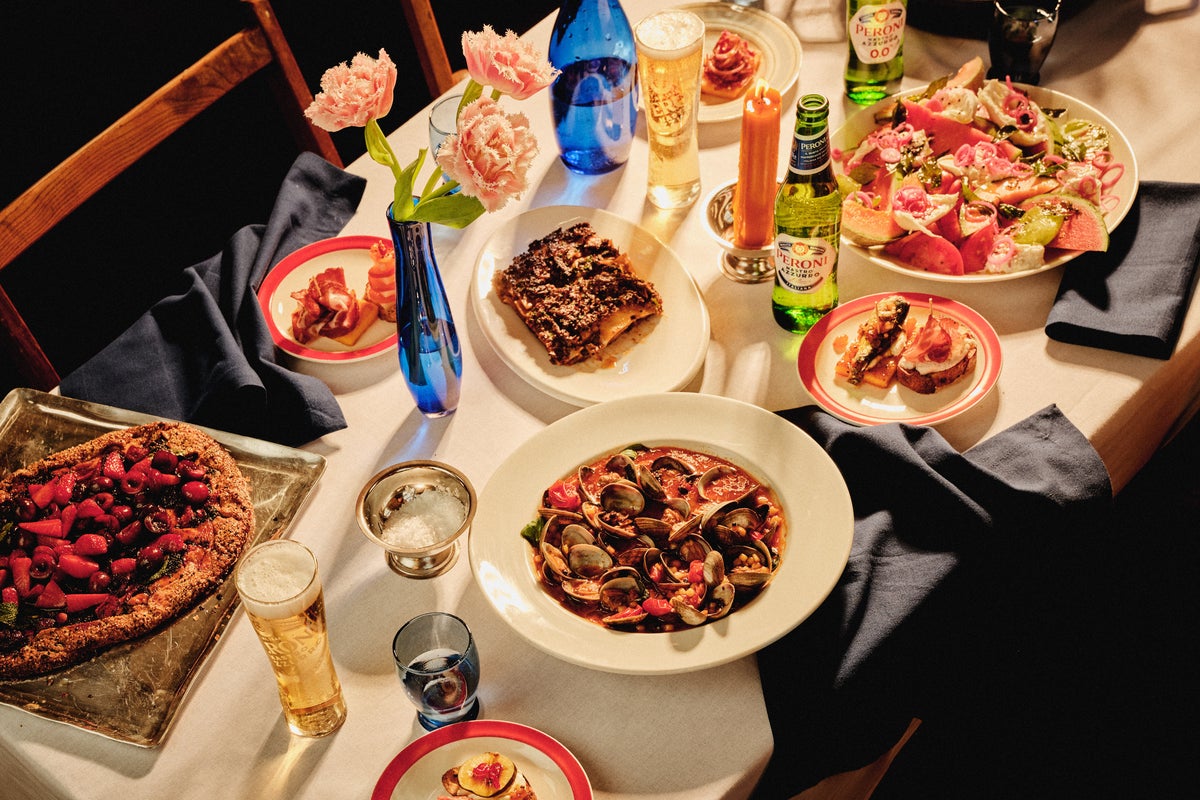
This summer, I’m returning to the place where my culinary story began, crafting a series of recipes alongside Peroni Nastro Azzurro that celebrate the Italy I grew up in and the landscapes that shaped me.
My recipes explore five of the most beautiful Italian regions. From Tuscany, where Ferruccio, my friend Giuditta’s grandfather, made fresh pasta that inspired my porcini lasagne, to the sun-dappled fondamente of Venice, where colourful displays of cicchetti line wooden counters.
Each corner of Italy has left a mark on my palate and my heart. I remember the salty breeze off Sardinia’s turquoise coast, the deep harmonies of cantu a tenore echoing through rocky coves; the heady scent of basil and tomato wafting through Capri; and the grit and romance of Rome, where every cobbled street spills stories as rich as the local ricotta.
Each recipe is inspired by these places I love, with creative twists of my own. Let this menu be a guide to discover the Italy of my childhood and an invitation to create your own Italian adventure.
Buon viaggio e buon appetito!
Tuscany: porcini and habanero lasagne
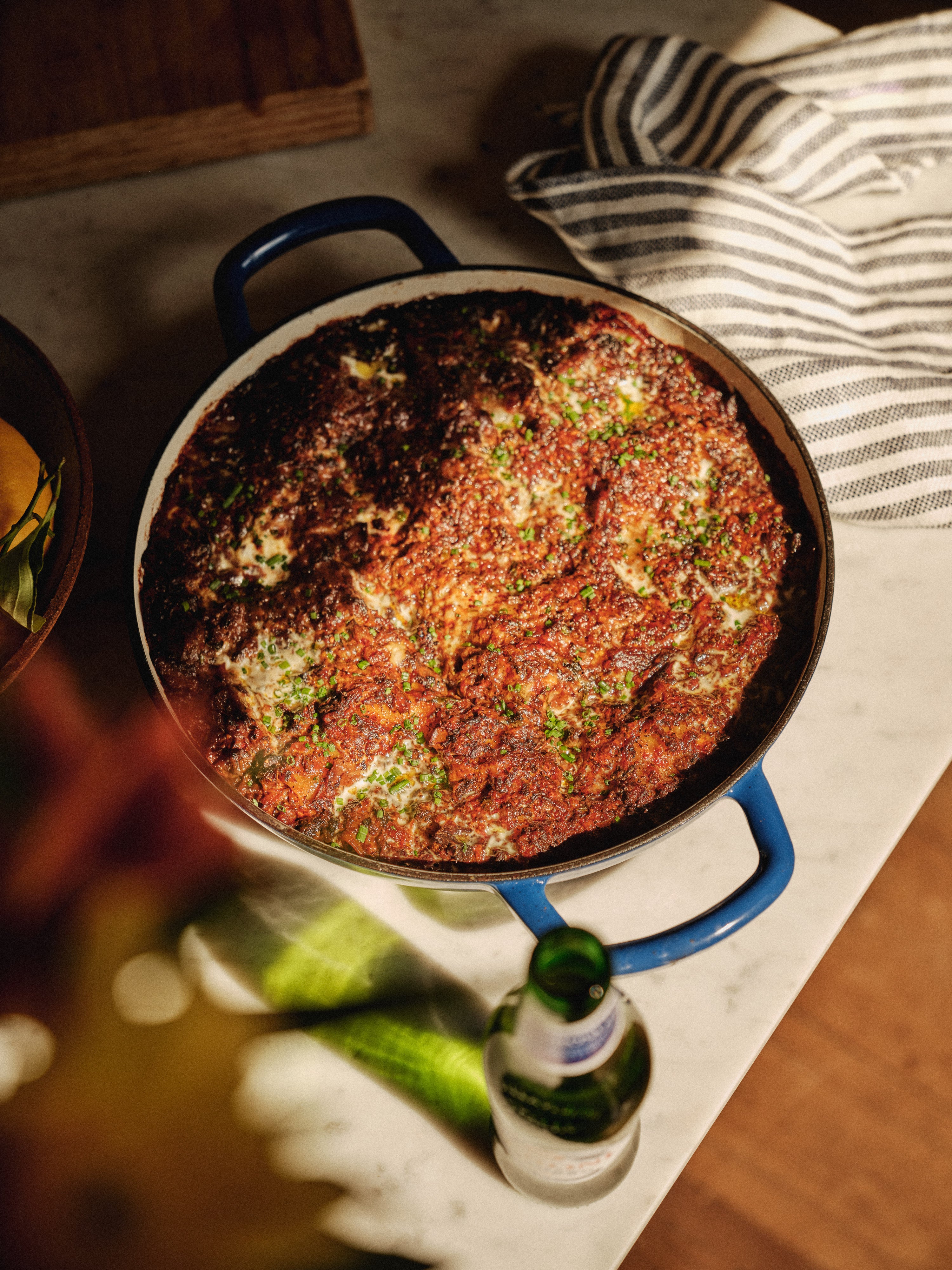
My own journey through Italy started in Tuscany, halfway up a mountain locally known as “Monte”. My father worked in the wine trade, specifically as an expert on Italian wine, and so we moved to Tuscany when I was young and the wheels were set in motion for my culinary journey.
We lived in the old servant quarters of a villa surrounded by rolling Tuscan hills, vineyards and olive groves as far as the eye could see, and my sister and I spent our days roaming the countryside with our dog Giacomino.
I quickly became best friends with a girl I met at school, Giuditta, whose family changed my life by introducing me to the best Tuscan food, via her uncle’s restaurant, La Casellina.
I fell in love with dishes like chicken liver crostini, tagliatelle with duck ragu, ravioli with crema di rucola, fritto misto of rabbit, courgette flowers and sage leaves and so much more…
Giuditta’s grandfather, Ferruccio, used to make all the pasta for La Casellina in the laundry room of their family house and so whenever I wentover, which was often, I would insist on going to hang out with Ferruccio to watch him make pasta. He knew that I thought his lasagne was thebest thing in the whole world, and so he made it for me every time I came to their house, and for decades after, whenever I came to visit.
My dish for Tuscany is named after my childhood home, Monte. It pays homage to Ferruccio, who made the best lasagne in the world, andto my all-time favourite dish: penne all’Aconese. This secret recipe has been served for nearly 50 years at the restaurant at the top of the mountain I grew up on. It’s deeply complex, and the rich flavour of porcini shines through.
The ragù in my lasagne is inspired by that same legendary sauce. Porcini, one of my favourite ingredients, brings a deep, punchy flavour. I’mpairing it with habanero, my favourite chilli. It’s not Italian, of course, but it works beautifully here. I like to think Ferruccio would approve.
Would recommend eating alongside a crisp Peroni Nastro Azzurro.
Serves: 6
Time: 1 hour 30 minutes
Ingredients:
750g chestnut mushrooms, halved
500g oyster mushrooms
135ml olive oil, plus extra for greasing
60g dried porcini mushrooms
30g dried wild mushrooms
500ml hot chicken or vegetable stock
1 onion, peeled and quartered
5 garlic cloves, roughly chopped
1 carrot, peeled and quartered (90g)
2-3 plum tomatoes, quartered (200g)
75g tomato paste
½ tsp dried red chilli flakes
¼ tsp dried habanero flakes
130g double cream
60g Pecorino Romano, finely grated
60g Parmesan, finely grated
5g basil leaves, finely chopped
10g parsley leaves, finely chopped
250g dried lasagne sheets (that’s about 14 sheets)
Salt and black pepper
Method:
1. Preheat the oven to 230C fan.
2. Put the chestnut and oyster mushrooms into the large bowl of a food processor in three or four batches and pulse each batch until finely chopped (or finely chop everything by hand). Toss the chopped mushrooms in a large bowl with 3 tablespoons of oil and 1 teaspoon of salt and spread out on a large, 40cm x 35cm parchment-lined baking tray.
3. Bake for 30 minutes near the top of the oven, stirring three times throughout, until the mushrooms are golden-brown; they will have reduced in volume significantly. Set aside. Reduce the oven temperature to 200C fan.
4. Meanwhile, combine the dried mushrooms and hot stock in a large bowl and set aside to soak for half an hour. Strain the liquid into another bowl, squeezing as much liquid from the mushrooms as possible to get about 340ml: if you have any less, top up with water. Very roughly chop the rehydrated mushrooms (you want some chunks). Set the stock and mushrooms aside separately.
5. Put the onion, garlic and carrot into the food processor and pulse until finely chopped (or finely chop everything by hand). Heat 60ml of oil in a large sauté pan or pot on a medium-high heat.
6. Once hot, add the onion mixture and fry for 8 minutes, stirring occasionally, until soft and golden. Pulse the tomatoes in the food processor until finely chopped (or finely chop by hand), then add to the pan along with the tomato paste, chilli, habanero, 1½ teaspoons of salt and 1¾ teaspoons of freshly cracked black pepper. Cook for 7 minutes, stirring occasionally. Add the rehydrated mushrooms and the roasted mushrooms and cook for 9 minutes, resisting the urge to stir: you want the mushrooms to be slightly crisp and browned on the bottom.
7. Stir in the reserved stock and 800ml of water and, once simmering, reduce the heat to medium and cook for about 25 minutes, stirring occasionally, until you get the consistency of a ragù. Stir in 100ml of the cream and simmer for another 2 minutes, then remove from the heat.
8. Combine both cheeses and both herbs in a small bowl. To assemble the lasagne, spread one-fifth of the sauce in the bottom of a round 28cm baking dish (or a 30cm x 20cm rectangular dish), then top with a fifth of the cheese mixture, followed by a layer of lasagne sheets, broken to fit where necessary. Repeat these layers three more times in that order, and finish with a final layer of sauce and cheese: that’s five layers of sauce and cheese and four layers of pasta.
9. Drizzle over 1 tablespoon of cream and 1 tablespoon of oil, then cover with foil and bake for 15 minutes. Remove the foil, increase the temperature to 220C fan and bake for another 12 minutes, turning the dish round halfway.
10. Set aside to cool for 5 or so minutes, then drizzle over the remaining tablespoon of cream and oil. Finish with a good grind of pepper and a drizzle of olive oil and serve.
Venice: cicchetti
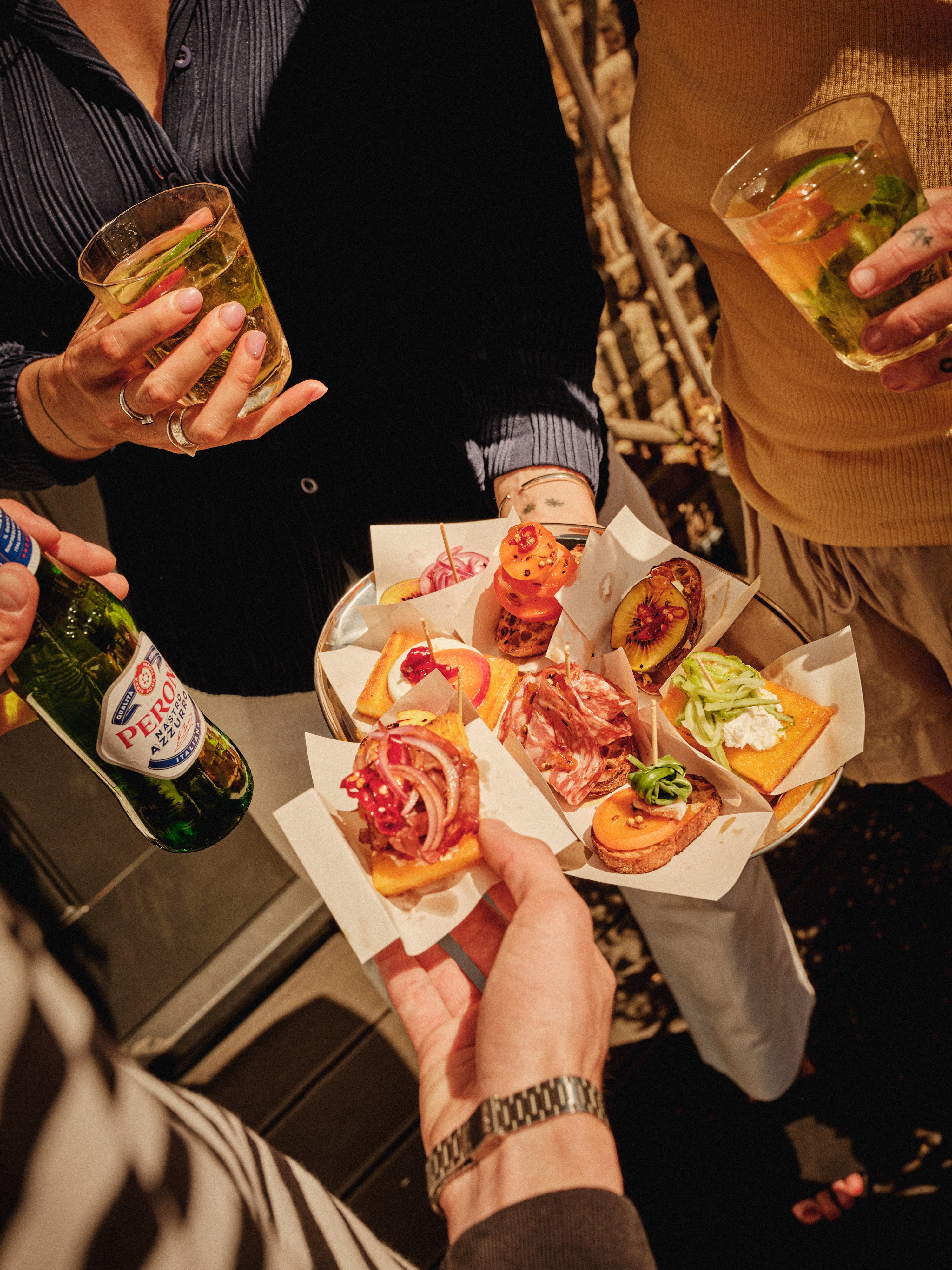
Being in Venice feels like stepping into another world. I remember the first time I went as a child; I was completely enchanted with how people once lived in this magical, floating city – getting from place to place by boat, with doorsteps opening directly onto the canals. I remember standing in Piazza San Marco, pigeons perched on my shoulders.
Venice is one of the most fun places in the world to bar hop: wandering from bacaro to bacaro, stopping for aperitivi and cicchetti. I love the Venetian tradition of cicchetti, especially the sweet-and-sour flavours of ingredients like saffron and raisins (a reminder of the city’s role as amajor hub in the spice trade during the Middle Ages and Renaissance).
These aromatic flavours were often accompanied by an ice-cold birra, poured into tumblers or sipped straight from the bottle, taking theedge off the Venetian summer heat.
My Venice course embodies this sense of casual roaming from bar to bar, picking up a cicchetti here, a cicchetti there: morsels of deliciousness, with each bite aimed to enchant and delight – just like the city itself.
Serves: 6
Time: 30 minutes
Sardines, golden raisins, saffron and yellow habanero
Ingredients:
For the raisin and saffron syrup:
100g golden raisins, roughly chopped
50g runny honey
50g lemon juice
1 tsp urfa chilli flakes
1 tsp saffron threads
½ tsp coriander seeds, toasted
½ tsp caraway seeds, toasted
½ tsp cumin seeds, toasted
¼ tsp yellow habanero paste
Everything else:
1 brown sourdough baguette, sliced and grilled
2 tins sardines in olive oil
100g ricotta
Extra virgin olive oil
Flaked sea salt
Black pepper
Method:
1. Add all the ingredients for the syrup to a small saucepan on a medium heat. Cook until the liquid begins to gently bubble and then reduces to the consistency of maple syrup, about 5 minutes. Leave to cool.
2. Drain the sardines, then add to the cooled raisin syrup.
3. Spread some ricotta on each slice of toast, then top with some of the sardines. Drizzle with olive oil and finish with flaked sea salt and black pepper.
Fried polenta cicchetti with nectarine and lardo
Ingredients:
For the polenta:
600ml water
1 tsp salt
1 tbsp olive oil
180g quick-cook polenta (the type that cooks in 7 mins or less)
Toppings:
70g peppered salami, sliced
100g lardo, sliced
100g ricotta
100g pecorino
3 nectarines, sliced
Runny honey
Chipotle paste
Extra virgin olive oil
Flaked sea salt
Method:
1. Line and grease a 20x20cm baking tray.
2. Bring the water and salt to a boil in a saucepan.
3. Slowly pour in the polenta, whisking constantly to prevent lumps. Lower the heat all the way down and whisk continuously for 4-5 minutes.
4. Pour the cooked polenta into the lined tray and level the top with a spatula.
5. Let it cool to room temperature, then place in the fridge until completely firm.
6. Turn out the set polenta and cut into 7x5cm rectangles. Heat a thin layer of olive oil in a frying pan over a medium-high heat.
7. Fry the pieces for 3-5 minutes per side, or until golden-brown and crispy.
8. Get creative with your toppings! Try combinations like ricotta, salami, and a drizzle of honey mixed with chipotle paste, or nectarine and a slice of torched lardo. Finish with extra virgin olive oil and flaked sea salt. Mix and match to find your favourite flavour pairings!
Sardinia: vongole, fregola and scotch bonnet

We visited Sardinia a few times when I was a kid. I remember the crystal-clear turquoise waters, soft white sand and the dramatic, rocky coastline, but one of my most vivid memories was staying at an Agriturismo, where the host served us a traditional dish of sheep’s head.
I’m more adventurous with food now, and I would try it the next time I visit, but I wasn’t brave enough back then.
The experience was accompanied by the traditional Sardinian music of cantu a tenore, sung in dialect. I remember hearing it for the first timeas a child, and it sounded so different.
The deep, guttural harmonies and the way the voices intertwined were unlike anything I’d ever heard before – raw, rich and timeless. The sound echoed through the air, and although I couldn’t fully understand it at the time, it felt deeply connected to the land and people of Sardinia, carrying centuries of history in every note.
My Sardinia course marries my memories of the sparkling Sardinian sea and the rich, timeless cantu a tenore music of the Sardinian people, with a little twist of my own. Vongole (or clams) are abundant in Sardinia’s coastal lagoons, estuaries and sandy sea beds – no doubt helping to filter the water, resulting in the crystalline blue that has captivated so many.
Fregola is a rich part of Sardinian tradition and history. I’ve also added Scotch bonnet, another of my favourite chillies that I cook with often.
Its fruity, smoky notes pair beautifully with the fregola, which I’ve lightly toasted before combining with the briny vongole and blistered tomatoes.
Serves: 6
Time: 1 hour
Ingredients:
150g fregola
70g olive oil
4 cloves of garlic, peeled and crushed with the side of a knife
1 Scotch bonnet chilli, whole and unpierced
200g sweet, ripe cherry tomatoes, such as Datterini, halved
1 tsp tomato purée/paste
½ tsp sweet paprika
½ tsp fine salt
10g fresh basil leaves
70g white wine
800g clams
2 lemons: 2 tbsp lemon juice and the rest cut into wedges
2 tbsp double cream (optional)
1 green chilli, thinly sliced (optional)
Freshly ground black pepper
Method:
1. Cook the fregola per packet instructions until al dente, then drain and refresh under cold water.
2. Put the oil, garlic, Scotch bonnet, tomatoes, tomato puree, paprika, salt, half the basil and plenty of pepper into a large sauté pan on a medium-high heat. Fry for 4 minutes, stirring often.
3. Add the wine, followed by the clams spread out as much as possible, and bring to a simmer. Once gently simmering, cover with a lid, turn the heat down to mediumlow and cook for about 5 minutes, or until all or most of the clams have opened.
4. Discard any clams that don’t open. Discard the Scotch bonnet, squeezing it into the sauce first if you like heat. Stir in the cooked fregola and lemon juice.
5. Drizzle over the cream (if using), then top with the green chilli and the remaining basil leaves, and serve with lemon wedges.
Capri: insalata caprese with melon, buffalo mozzarella, pickled shallots and crispy basil
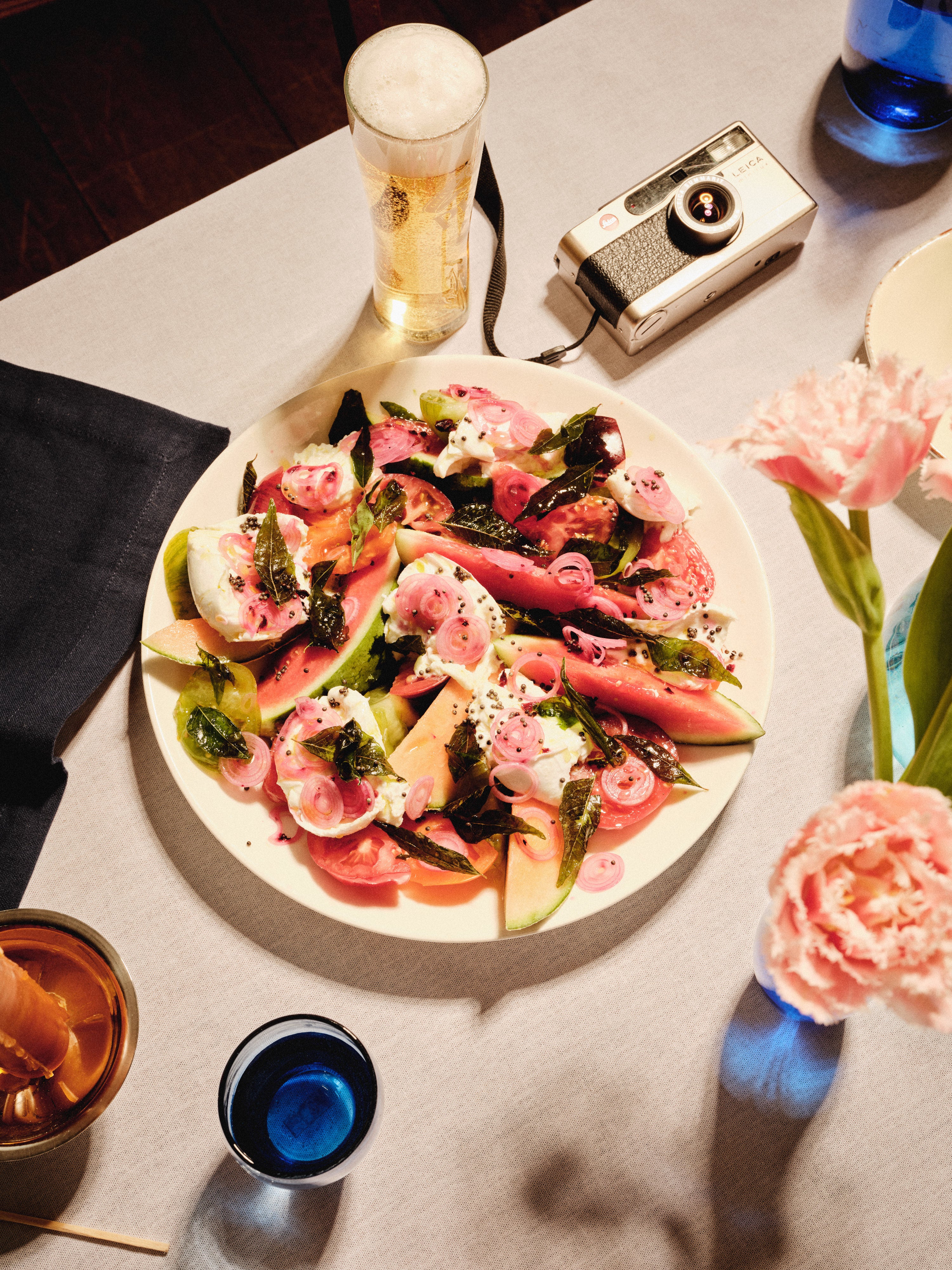
Insalata caprese is perhaps one of the most symbolic dishes of Italy, let alone Capri. Not only does it champion simple, home-grown Italianingredients, but it also reflects the colours of the Italian flag itself, with its vibrant red tomatoes, creamy white mozzarella and fresh green basil. As someone who grew up in Italy, but who is not Italian in heritage, I connect to Capri and its most famous dish in a slightly different way.
My memories of my childhood summers are filled with heady scents of the ripe tomatoes and fragrant basil that grew in the horto (vegetable garden) next to my house. These ingredients form a bedrock of not only Italian cooking, but my own.
I wanted to celebrate Capri by honouring its most famous dish, with a twist. I’ve added melon and pickled shallots to enhance the idea oflayering flavours and colours, as well as crispy basil and toasted mustard seeds for texture. It brings together the ingredients I loved as a child,with the techniques and flavours I’ve cultivated on my culinary journey as an adult. Eaten alongside a chilled Peroni Nastro Azzurro, with its subtle citrus and floral notes, I guarantee this dish will transport you to the sun-drenched shores of The Emerald Island.
Serves: 6
Time: 1 hour
Ingredients:
1 large banana shallot, finely sliced into rounds
2 lemons: finely grate the zest to get 1⁄2 tsp, then juice to get 3 tbsp
60ml olive oil
15g fresh curry leaves
15g fresh basil leaves
2 tsp black mustard seeds
1 small watermelon, skin on or off, halved lengthways, then cut into 2cm-thick triangles (700g skin-on weight)
500g heritage tomatoes, in a variety of colours
2⁄3 cantaloupe melon, skin on or off, deseeded and cut into 8 wedges (600g skin-on weight)
2 balls of buffalo mozzarella, roughly broken into 10 pieces
Method:
1. In a small bowl, combine the shallots with the lemon juice and a good pinch of flaked salt.
2. Put the oil into a small saucepan on a medium-high heat. Once hot, fry the curry and basil leaves and black mustard seeds for 30 seconds to 1 minute, swirling the pan, until crisp and fragrant. Strain through a sieve set over a small bowl, setting the oil and aromatics aside separately.
3. Chop the tomatoes into random large chunks and arrange on a large platter. Arrange the watermelon, cantaloupe and mozzarella on top, then sprinkle with 1 teaspoon of flaked salt.
4. Drizzle over the aromatic oil, then sprinkle over the shallots and lemon juice. Leave to sit for 10 minutes, or up to 1 hour, for the flavours to come together.
5. Finish with the lemon zest, fried mustard seeds, crispy curry and basil leaves, and serve.
Rome: Ricotta, sour cherry and strawberry crostata
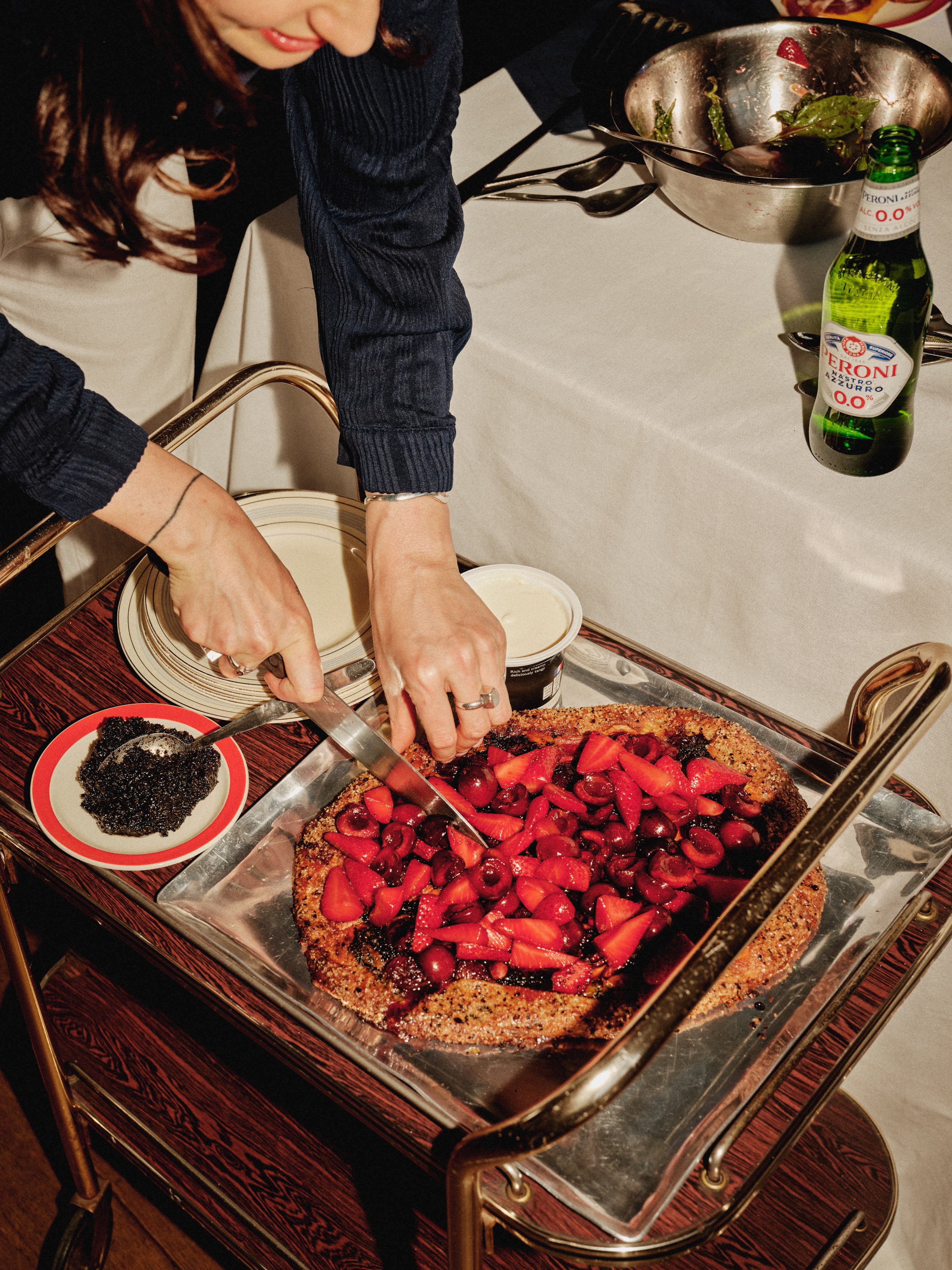
From my time in Rome, the locals are what I remember most vividly: charismatic, passionate, and hospitable with a sharp wit and biting sarcasm. The city itself exudes these qualities: in parts beautiful and in parts rough around the edges, steeped in history and utterly romantic.IPeroni has been producing birra in its brewery in Rome since 1864, meaning the city and its people are a huge part of its history. When you drink a Peroni in its heartland, you don’t just taste the beer, you taste the passion and heart of the city.
The dish I’ve created to represent Rome has its origins in Rome’s Jewish neighbourhood, inspired by Boccione, the oldest surviving bakeryin the area. A crostata is Italy’s rustic answer to a tart, typically made free-form without the need for a tart dish. The result is the irreverentcousin to the polished pie. Creamy ricotta combines with sour cherry in the classic version, but again, I’ve added some personal touches.
I’ve combined the cherries with strawberries to enhance the vibrancy, as well as a little pomegranate molasses to marry the fruits together.
The pastry is made with spelt and almond flour, with a touch of ancho chilli, and I’ve added a black sesame praline for good luck. I’d recommendenjoying it with a refreshing Peroni Nastro Azzurro 0.0%. The touch of nuttiness and mild toasted flavours in the beer work beautifully with the pastry, and its lightness compliments the crostata’s gutsiness.
I’ve named the dish ‘The Eternal City’ after Rome’s famous nickname, a nod to its enduring legacy and cultural significance, which seeps through every corner of Rome.
Serves: 6
Time: 1 hour 30 minutes
Ingredients:
For the pastry:
110g unsalted butter, chopped into 3cm pieces and frozen
140g wholemeal spelt flour
60g soft light brown sugar
85g ice-cold water
25g quick-cook polenta
25g ground almonds
20g olive oil
Zest of 1 tangerine
¼ tsp ground cinnamon
¼ tsp fine sea salt
For the ricotta:
180g full-fat ricotta
2 egg yolks
40g runny honey
Zest of 1 tangerine
½ tsp vanilla bean paste Macerated fruit
200g cherries, pitted and halved
200g strawberries, stalks removed and roughly chopped
30g runny honey
20g pomegranate molasses
10g basil
10g tangerine juice
1 tsp vanilla bean paste
For the black sesame praline:
80g black sesame seeds, very well toasted
80g maple syrup
2 tsp brown rice miso paste
1 tsp vanilla bean paste
¼ tsp toasted sesame oil
Everything else:
1 egg yolk, for egg wash
Demerara sugar
Urfa chilli
150g ricotta, to serve
Method:
1. Add all the pastry ingredients to a large bowl and stir to combine. Bring together with your hands into a ball but don’t overwork the dough, you want visible pieces of butter throughout.
2. Dust your work surface with regular flour. Tip the pastry out onto it and roll into an A4-sized rectangle, flouring the pin, pastry andsurface as needed so the pastry doesn’t stick to the surface.
3. Fold the shorter ends of the pastry to meet in the middle, roll out, then fold the longer sides in to meet in the middle and roll out again. Flour the surface, pastry and rolling pin as you go. Fold the pastry in half, roll out once more, then fold in half again. Shape into a smooth round circle, approx 12cm. Cover tightly with cling film and freeze for 30 mins.
4. Mix all the ingredients for the macerated fruit together.
5. Whisk all the ricotta ingredients together until smooth. Keep refrigerated.
6. Add all the praline ingredients to the small bowl of a food processor and blend until smooth.
7. Once the dough has chilled, flour your surface again and roll the pastry out into a 36cm-wide oval shape.
8. Transfer to a large, parchment-lined baking tray that fits in the fridge, then refrigerate for 30 mins.
9. Preheat the oven to 200C fan.
10. Remove the pastry from the fridge and spread over the ricotta mix, leaving a 4cm rim around the edge.
11. Top the ricotta yoghurt mix with half of the macerated fruits (avoiding basil/not too much liquid) and leaving the 4cm rim uncovered.
12. Fold the edges up and over the edges of the fruit. Brush the exposed pastry with egg, then sprinkle with a mix of demerara sugar + urfa chilli.
13.Bake for 30 minutes, rotating the tray half way. Leave to cool for 15 mins, then top with the remaining macerated fruit. Serve with the sesame praline and more ricotta.
Peroni Nastro Azzurro and peach iced tea cooler
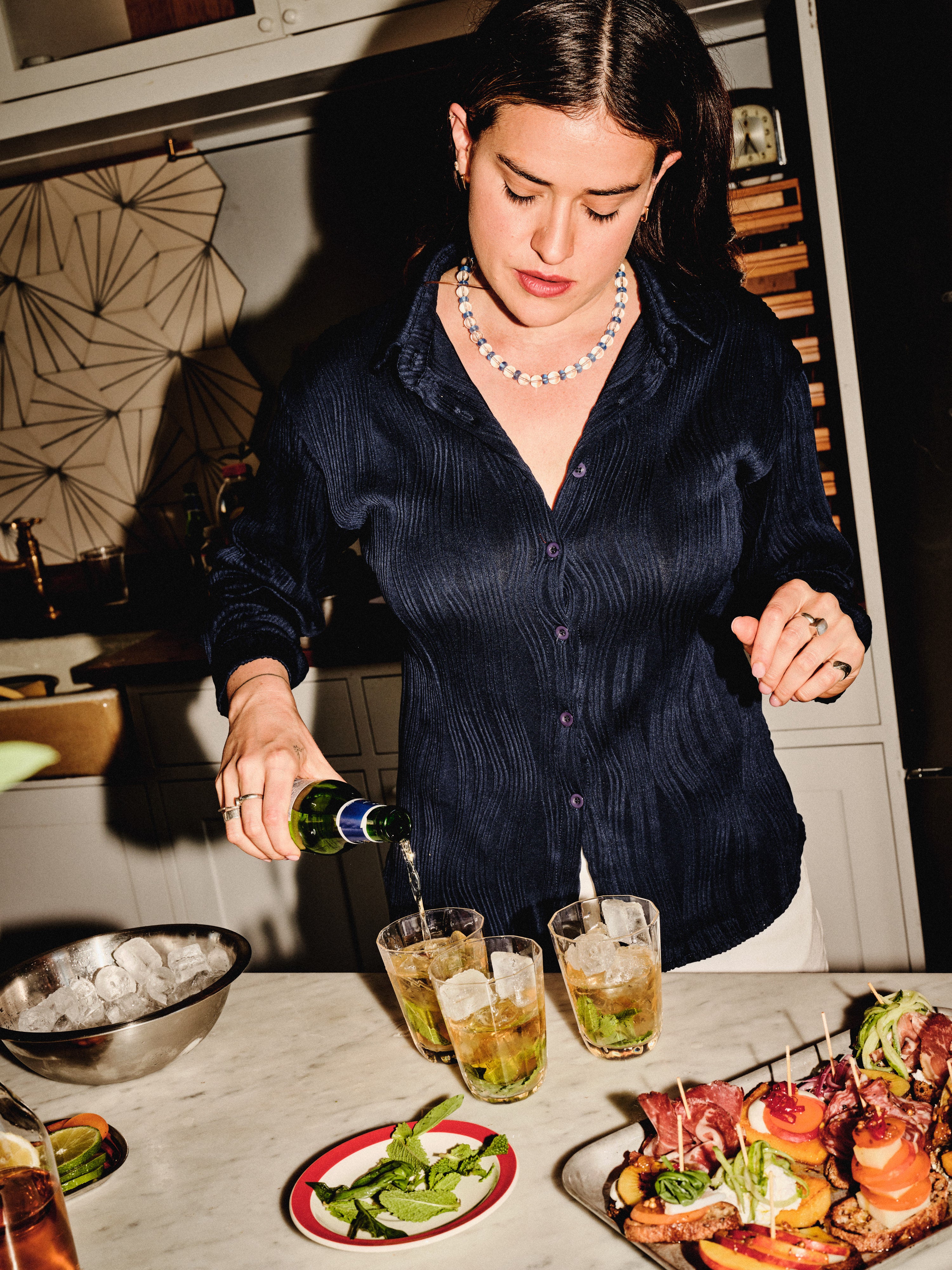
Ingredients:
480ml peach iced tea
30ml lemon juice
12 basil leaves
12 mint leaves
6 drops cinnamon essence
To finish:
Ice
240ml peroni
6 slices of peach
6 slices of lime
Method:
1. Add the iced tea, lemon juice, basil, mint and cinnamon essence to a jug and stir.
2. Fill six tumblers with ice, then divide the iced tea mixture between the glasses.
3. Top each glass with 40ml Peroni, then finish with the peach and lime garnish and serve.
These recipes were created in partnership with Peroni Nastro Azzurro







